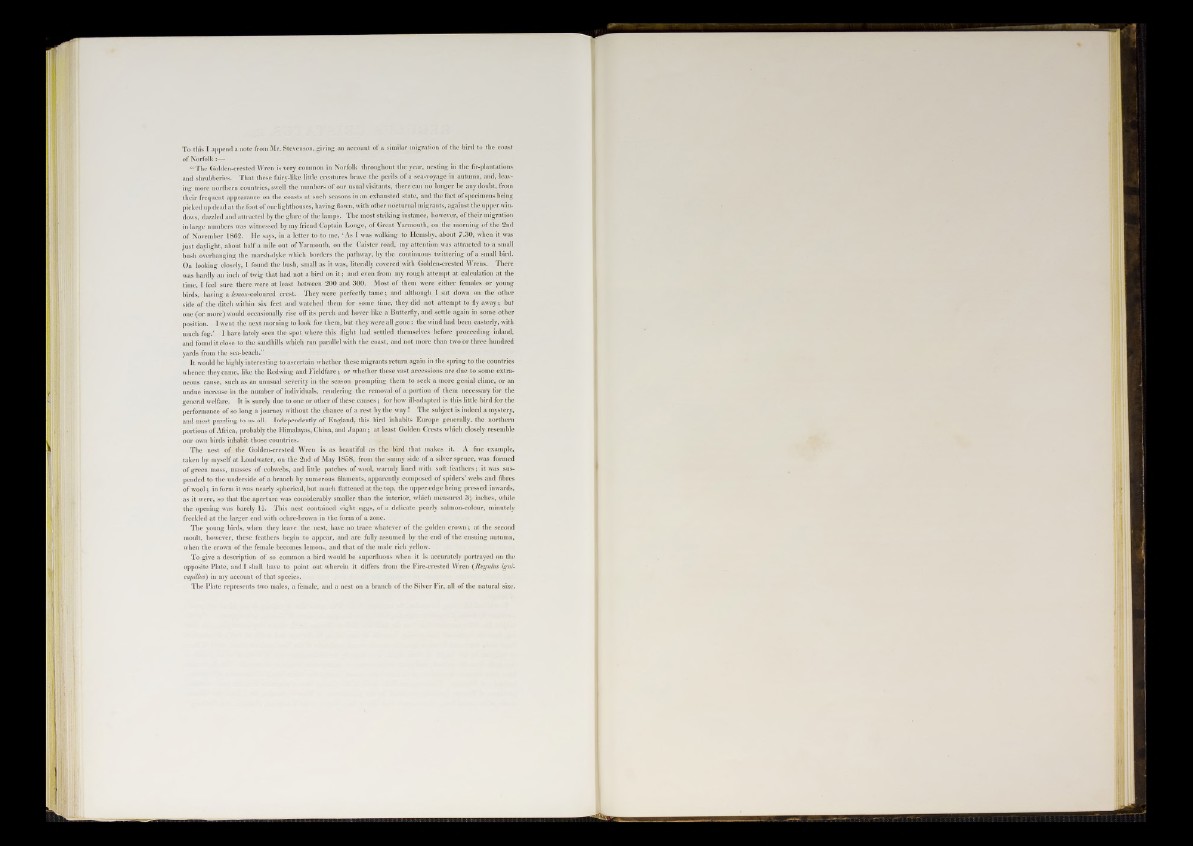
To this I append a note from Mr. Stevenson, giving an account of a similar migration of the bird to the coast
of Norfolk :—*
“ The Golden-crested Wren is very common in Norfolk throughout the year, nesting in the fir-plantations
and shrubberies. That these fairy-like little creatures brave the perils of a sea-voyage in autumn, and, leaving
more northern countries, swell the numbers of our usual visitants, there can no longer be any doubt, from
their frequent appearance on the coasts at such seasons in an exhausted state, and the fact of specimens being
picked up dead at the foot of our lighthouses, having flown, with other nocturnal migrants, against the upper windows,
dazzled and attracted by the glare of the lamps. The most striking instance, however, of their migration
in large numbers was witnessed by my friend Captain Longe, of Great Yarmouth, on the morning of the 2nd
of November 1862. He says, in a letter to to me, ‘As I was walking to Hemsby, about 7.30, wben it was
just daylight, about half a mile out of Yarmouth, on the Caister road, my attention was attracted to a small
bush overhanging the marsh-dykc which borders the pathway, by the continuous twittering of a small bird.
On looking closely, I found the bush, small as it was, literally covered with Golden-crested Wrens. There
was hardly an inch of twig that had not a bird on i t ; and even from my rough attempt at calculation at the
time, I feel sure there were at least between 200 and 300. Most of them were either females or young
birds, having a/«MOH-coloured crest. They were perfectly tame; and although I sat down on the other
side of the ditch within six feet and watched them for some time, they did not attempt to fly away; but
one (or more) would occasionally rise off its perch and hover like a Butterfly, and settle again in some other
position. I went the next jnorning to look for them, but they were all gone: the wind had been easterly, with
much fog.’ I have lately seen the spot where this flight had settled themselves before proceeding inland,
and found it close to the sandhills which run parallel with the coast, and not more than two or three hundred
yards from the sea-beach.”
It would be highly interesting to ascertain whether these migrants return again in the spring to the countries
whence they came, like the Redwing and Fieldfare; or whether these vast accessions are due to some extraneous
cause, such as an unusual severity in the season prompting them to seek a more genial clime, or an
undue increase in the number of individuals, rendering the removal of a portiou of them necessary for the
general welfare. It is surely due to one or other of these causes; for how ill-adapted is this little bird for the
performance of so long a journey without the chance of a rest by the way! The subject is indeed a mystery,
and most puzzling to us all. Independently of England, this bird inhabits Europe generally, the northern
portions o f Africa, probably the Himalayas, China, and Jap an ; at least Golden Crests which closely resemble
our own birds inhabit those countries.
The nest of the Golden-crested Wren is as beautiful as the bird that makes it. A fine example,
taken by myself at Loudwater, on the 2nd of May 1858, from the sunny side of a silver spruce, was formed
of green moss, masses of cobwebs, and little patches of wool, warmly lined with soft feathers; it was suspended
to the underside of a branch by numerous filaments, apparently composed of spiders’ webs and fibres
of wool; in form it was nearly spherical, but much flattened at the top, the upper edge being pressed inwards,
as it were, so that the aperture was considerably smaller than the interior, which measured 3j- inches, while
the opening was barely ltr. This nest contained eight eggs, of a delicate pearly salmon-colour, minutely
freckled at the larger end with ochre-brown in the form of a zone.
The young birds, when they leave the nest, have no trace whatever of the golden crown ; at the second
moult, however, these feathers begin to appear, and are fully assumed by the end of the ensuing autumn,
when the crown of the female becomes lemon-, and that of the male rich yellow.
To give a description of so common a bird would be superfluous when it is accurately portrayed on the
opposite Plate, and I shall have to point out wherein it differs from the Fire-crested Wren (Regains igni-
capillus) in my account of that species.
The Plate represents two males, a female, and a nest on a branch of the Silver Fir, all of the natural size.